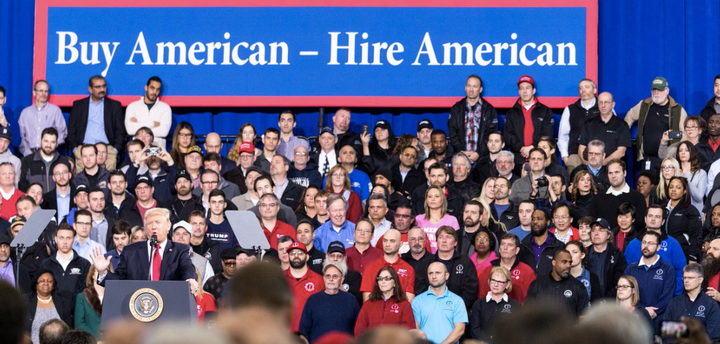
Donald Trump Speaking in Michigan
Held in the middle of one of the most tumultuous eras of American politics, the 1965 New York Mayoral Election marked an important turning point in our history. The handsome John Lindsay, a progressive Republican at a time when the party had their fair share of liberals, managed to etch out a victory against future mayor Abraham Beam, a typical Tammany Hall Democrat. Lindsay would go on to serve two terms as mayor before watching his political career falter, but he may not have become mayor at all were it not for one man: William F. Buckley. While the late conservative intellectual is now better known for his philosophical contributions to the American right, he had a brief — but significant — career as a politician.
Buckley knew that he wouldn’t win the election. That wasn’t why he was running. In reality, the only real motive for Buckley was that he didn’t want to see a liberal Republican like Lindsay do well, lest John Lindsay become a central figure in the GOP and set back the young but burgeoning conservative movement. But, while Buckley may have hoped to stop Lindsay by chipping off Republican-leaning millionaires, his strongest support actually came from ethnic whites, or what we’d now call the “white working class.” In contrast, Lindsay, an Upper-East Sider and a quintessential member of the “liberal elite,” won by driving up the score with marginalized populations that saw a champion in him. Throughout his mayoralty, Lindsay would fight for the rights of African-Americans, Latinos, and even the LGBTQ community, earning their support–as well as the disdain of the white working class. Fifty-two years later, the politics of 1965 New York remain astoundingly relevant.
While the white working class may not have had the political capital to even come close to electing Buckley, it was (barely) able to elect Donald Trump. But Trump was merely the capstone of white working class support for the GOP: For the first time in decades–and probably in all of American history–the white ethnic working class is the cornerstone, the central bloc, of the Republican Party’s voting base. This has understandably stunned liberals, partially because such voters formed a critical bloc of the Democratic Party as recently as thirty years ago. But it’s also because, from a liberal perspective, the Democratic Party should be the natural home of the white working class. After all, the Democratic Party is the one that stands up to big business. The Democratic Party is the one that stands up for Medicare and other entitlement programs. The Democratic Party is the one that rejects generous tax breaks for the 1%. The Democratic Party is the one that stands up for the workingman. And yet the Democratic Party seems unable to earn the support of the very people it claims to champion.
Why? Opinions vary; the “Establishment” wing of the party (e.g. Nancy Pelosi, Seth Moulton, the Crooked Team) believes that the Democratic Party needn’t make any policy changes. They say that the party already has policies to support these voters in place and that the real problem comes from a failure to communicate them. The “Progressive” wing (e.g. Bernie Sanders, Elizabeth Warren, Keith Ellison) says that the problem is systematic, that the party is not with working people and must move further to the left to earn their support. And then, of course, there are your Thomas Franks, who more or less say that the real problem is that working class citizens have been brainwashed into supporting Republicans by way of the culture wars. Each diagnoses is compelling and persuasive, but also fundamentally wrong headed. The problem is that every pundit who holds these views has forgotten a fundamental rule of anthropological research (and the entire American working class is so foreign to Jon Lovett that we should call it anthropological): relativism. Each and every one of them asks, “How could these people who would so clearly benefit from Democratic policies vote Republican? What could possibly lead them to do such a thing?” As a result, they more or less try to figure out what might lead them to support Republicans if they were in the white working class’s shoes, seemingly without considering the possibility that the white working class views the world and its problems in a completely different way.
But the problem is that they do see the world a different way. They see most problems and solutions differently, which ultimately renders a lot of proposed solutions politically worthless.
Take Trump’s budget proposal as an example.
Looking at it from a policy perspective, the plan is abysmal and would do nothing to make America great. The military budget in the U.S. is already sky high; the EPA–the program that helps keep the Mississippi River clean–is already cut to the bones; the National Endowment for the Arts is already underfunded, and it supports our museums, not starving artists bumming off of government assistance; the state department saves American lives by using diplomatic methods to solve conflicts, and it keeps relations with our allies intact; and if there’s a hammock sustaining the lives of welfare queens, it’s a poorly built hammock made of rusted nails and under-funded programs, the same programs used to help the elderly and disabled. But, even though the budget probably won’t make it through Congress as is, I’m guessing that it’s the kind of budget that Trump’s base were hoping he’d introduce.
Trump supporters tend to be skeptical of human-caused climate change and any regulatory solutions to the issue; this is probably because many voters believe these “solutions” do little more than eliminate good jobs for blue-collar workers. So, a cutback on the EPA not only reduces frivolous spending, it creates jobs! The N.E.A.? Another example of wasteful government spending that takes tax-dollars from the hardworking and gives it to something worthless. The state department? You can’t defeat ISIS with words. And those welfare programs? All they do is subsidize undeserving idlers at the expense of the workingman, yet another example of how the government is corrupt and has to be drained. And those Goldman Sachs bankers riddled among his cabinet? It seems that supporters don’t really blame the wealthy for our problems, even if his campaign rhetoric would seem to suggest otherwise. In their minds, businesses are private, create jobs, and are therefore responsible to no one but themselves and their stockholders; why else would they have trusted a businessman enough to elect him? Instead, many of them feel that the primary fault for the Great Recession lay with the government, who takes their money and then squanders it. It’s important to note that this doesn’t mean their views are necessarily in line with the mainstream Republican Party; they just think that the way the government currently spends is wasteful, not all government spending per se (see Medicare.)
They do feel that the wealthy should pay more taxes, but not as strongly as they feel they themselves should pay fewer. They also tend to believe that higher spending on schools is okay, so long as none of that extra pay goes to teachers. I could go on and on, but my point is this: Trump supporters see the world very differently. They do practice identity politics, and they think that someone is eating their share of the pie. They do support big government programs, but only to the extent that these programs help themselves, not everyone else. In their minds, they “earned” their right to Medicare and Social Security, but no one earns the right to healthcare simply by being alive. They think the problems of the working poor simply come from the fact that they aren’t willing to work, and they’d be fine if they got jobs.
Additionally, there’s a real resentment from working class Americans towards wealthier Americans. When I say wealthy, I’m not referring to Lloyd Blankfein or the Koch brothers; I’m talking about people who come from affluent communities like San Jose or Schaumburg. While most of these Americans think of themselves as middle-class, most of their fellow citizens would probably disagree. The residents in these areas dominate the political conversation, meaning that before Trump, a disproportionate amount of the political conversation was focused on the concerns of the wealthiest 25 percent of Americans. Meanwhile, many white working class members felt that their opinions and concerns were not only ignored, but were consciously disregarded and mocked by the “elite.” And if we’re being honest, it’s true. Whenever the elites do come up with solutions they say are supposed to benefit the working class, they’re thought up without any input from the very people they’re supposed to help. Some of the worst places to be poor or middle class in this country are also the most liberal. Only some of this is due to policy (though it’s usually when Democrats refuse to close down public schools in wealthy neighborhoods instead of poor,) but it gives the Republican Party some outstanding selling points about how the Democrats can’t run a government.
Many liberals like to view themselves as champions for the working class, but many working class citizens from all backgrounds seem to disagree. And as someone who works in a warehouse that employs a lot of minorities, I can confirm that these views are not exclusive to the white working class. While white working class and minorities may not agree on issues like trade or police reform, they aren’t far apart on issues like trans-gender rights, abortion, military intervention, or “welfare queens” (I’ve personally heard minority members of the working class complain about how people on welfare have better lives than they do.) I’ve often wondered how large a coalition a Trump-like candidate without his racial dog whistles and conspiracy theories could form.
It may sound weird that these are the sentiments held by the white working class, but, in the context of history, it really isn’t all that strange. While many like to think of the 1930s-40s as the triumph of progressivism in the U.S. (and, in a sense, it was,) a lot of white working class voters never completely bought into it. Throughout the Depression, the War, and beyond, Southern voters kept sending conservative, Blue Dog Democrats like Joe Robinson and John Garner to Washington, and these men always found their way into important leadership positions once there. They were fairly progressive on women’s rights, but that’s about it. These men (and they were all men) are why we didn’t establish a national health care service in the 1940s and why it took until the 1960s to desegregate. They fought the creation of a universal welfare state, and they opposed the 1964 Immigration and Nationality Act. They resisted most aspects of the New Deal, and formed an integral part of the informal conservative coalition. Working class voters turning to a candidate like Trump is not an aberration, it’s a return to normal.
I’m not writing any of this to criticize or praise the working class, and I’m certainly not proposing that the Democratic Party create a platform that caters completely to the working class’s sentiments. While I sympathize with some working class resentments, my own views are generally somewhere to the left of Barack Obama and right of Bernie Sanders. But, I am arguing that a lot of Democrats are talking about the working class without talking to them, meaning that they don’t get what they want or value. If the folks on Pod Save America want to talk about the working class and what they want, maybe they should stop making assumptions and do some homework.
